

China: Chengdu rolls out intelligent rubbish bins - BBC News. Water treatment. Water treatment is any process that makes water more acceptable for a specific end-use.
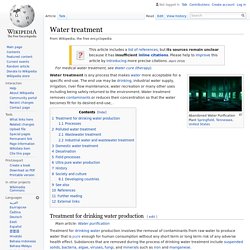
The end use may be drinking, industrial water supply, irrigation, river flow maintenance, water recreation or many other uses including being safely returned to the environment. Water treatment removes contaminants or reduces their concentration so that the water becomes fit for its desired end-use, . Treatment for drinking water production[edit] Treatment for drinking water production involves the removal of contaminants from raw water to produce water that is pure enough for human consumption without any short term or long term risk of any adverse health effect. Ministry of Land, Infrastructure, Transport and Tourism. Crazy paving: Rotterdam to consider trialling plastic roads. The Netherlands could become the first country in the world where the streets are paved with plastic bottles after Rotterdam city council said it was considering piloting a new type of road surface touted by its creators as a greener alternative to asphalt.

Construction firm VolkerWessels unveiled plans on Friday for a surface made entirely from recycled plastic, which it said required less maintenance than asphalt and could withstand more extreme temperatures of between minus 40C and 80C. Vancouver. Euralille. The two office towers designed by Christian de Portzamparc (left) and Claude Vasconi (right) above the Lille Europe railway station, seen from the Avenue Le Corbusier Euralille is an urban quarter in the centre of Lille, France.
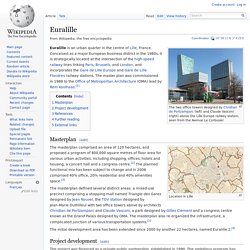
Conceived as a major European business district in the 1980s, it is strategically located at the intersection of the high-speed railway lines linking Paris, Brussels, and London, and incorporates the Gare de Lille Europe and Gare de Lille Flandres railway stations. The master plan was commissioned in 1988 to the Office of Metropolitan Architecture (OMA) lead by Rem Koolhaas.[1] Masterplan[edit] Congestion pricing. For the broader concept of direct charges paid by road users, see road pricing.
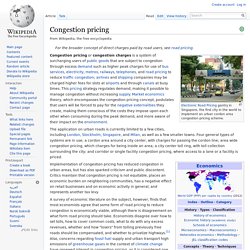
Electronic Road Pricing gantry in Singapore, the first city in the world to implement an urban cordon area congestion pricing scheme. Implementation of congestion pricing has reduced congestion in urban areas, but has also sparked criticism and public discontent. Critics maintain that congestion pricing is not equitable, places an economic burden on neighboring communities, has a negative effect on retail businesses and on economic activity in general, and represents another tax levy.
Global city. The most complex of these entities is the "global city", whereby the linkages binding a city have a direct and tangible effect on global affairs through socio-economic means.[1] The use of "global city", as opposed to "megacity", was popularized by sociologist Saskia Sassen in her 1991 work, The Global City: New York, London, Tokyo[2] though the term "world city" to describe cities that control a disproportionate amount of global business dates to at least the May 1886 description of Liverpool by The Illustrated London News.[3] Patrick Geddes also used the term "world city" later in 1915.[4] Cities can also fall from such categorization, as in the case of cities that have become less cosmopolitan and less internationally renowned in the current era.
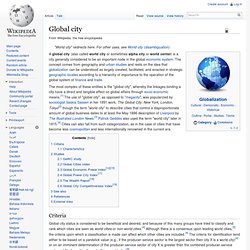
Criteria Characteristics Although what constitutes a world city is still subject subject to debate, standard characteristics of world cities are:[6] Studies GaWC study. Globalization and World Cities Research Network. The Globalization and World Cities Research Network, commonly abbreviated to GaWC, is a think tank based in the Geography department at Loughborough University in England, that studies the relationships between world cities in the context of globalization.

GaWC was founded by Peter J. Taylor in 1998,[1] and is best known for its categorization of world cities into alpha, beta and gamma tiers, based upon their international connectedness.[2] References[edit] External links[edit] Globalization and World Cities Research Network official site. Global city. George street light rail sydney. Solaroad. Living with Wildfire - The New Yorker. On the afternoon of September 15th, in the small northern California town of Weed, a fire began burning in the dry grass near the Boles Creek Apartments.
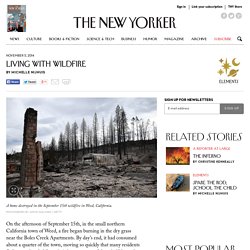
By day’s end, it had consumed about a quarter of the town, moving so quickly that many residents fled empty-handed from their homes, some of them half dressed. Though Weed is famous for its wind—the town’s much lampooned name is the legacy of Abner Weed, a sawmill operator who was looking for a place to dry his lumber—never before had that wind combined with heat and drought to such destructive ends. As much of the American West gets warmer and drier, wildfire season is getting longer, busier, and more frightening. But fire, unlike other natural hazards, is still widely considered an enemy to be defeated, rather than a fact of life that must be accepted.
There have been attempts, especially in the past two decades, to change this tendency. “We don’t just have a forest-fire problem,” Moritz told me. World's first solar cycle lane opening in the Netherlands. The bike path that connects the Amsterdam suburbs of Krommenie and Wormerveer is popular with both school children and commuters: around 2,000 cyclists ride its two lanes on an average day.

But next week Krommenie’s cycle path promises to become even more useful: on 12 November a 70-metre stretch will become the world’s first public road with embedded solar panels. Winners Stories 2014. From a pool of 29 finalists some 17 recipients took delivery of their award on Friday 12 September.

All nominations received were of a high standard and reflected the good work being done by a range of people across multiple communities of interest. The six category winners projects appear below.These stories will inspire you. Where you see the speaker icon, click to hear their brief chat when accepting their award. Category Winners - (L to R) Marcus Geisler, Authority Chairman; Simon Whitehouse, Karratha Enviro Group; Kirsty Grey and Graeme Lockhardt, WA Police; Rebecca Brown, WALGA; The Hon Albert Jacob, Minister for Environment; Cathy Wright and Peter Callaghan, Kojonup District High School; Andrew & Margaret Macindoe; City of Bunbury/Shire of Capel Waste Wise Schools category - Kojonup District High School. Waste Authority WA. Bunbury composting. Bunbury composting facility. Central business district. A central business district (CBD) is the commercial and often geographic heart of a city.

[citation needed] In the United States, it is commonly called "downtown" or "city center". The latter term is also commonly used in Australia, Canada, Ireland and the United Kingdom. A central business district may also be called a central activities district. [citation needed] Elektromotive. Elektromotive is a UK based company specialising in the manufacture and installation of charging infrastructure for electric cars and other electric vehicles, using their trade name of Elektrobay.[1][2] The company has partnerships with major corporations including EDF Energy[3] and Mercedes-Benz[4] to supply charging posts and data services.
History[edit] Elektromotive was founded in 2003 by former photographer Calvey Taylor-Haw,[5] Mechanical Engineer Greg Simmons [6] and motorsport notoriety Mike Earle [7] in Brighton. Berkeley Square. Berkeley Square in 1830. Berkeley Square, 2005 Berkeley Square, 2007. Bois de Vincennes. Coordinates: The Temple of Love on Lac Daumesnil in the Bois de Vincennes The Bois de Vincennes (French pronunciation: [bwɑ d‿vɛ̃sɛn]), located on the eastern edge of Paris, is the largest public park in the city. City Beautiful movement. The City Beautiful Movement was a reform philosophy of North American architecture and urban planning that flourished during the 1890s and 1900s with the intent of introducing beautification and monumental grandeur in cities. The movement, which was originally associated mainly with Chicago, Cleveland, Detroit, and Washington, D.C. promoted beauty not only for its own sake, but also to create moral and civic virtue among urban populations.[1] Advocates of the philosophy believed that such beautification could thus promote a harmonious social order that would increase the quality of life, while critics would complain that the movement was overly concerned with aesthetics at the expense of social reform; Jane Jacobs referred to the movement as an "architectural design cult".[2] History[edit] Origins and effect[edit]
Parc des Buttes Chaumont. List of cemeteries in Australia. This is a list of cemeteries in Australia. New South Wales[edit] Venue hire - Windmill Hill City Farm - Windmill Hill City Farm. St Werburghs City Farm. Boiling Wells is a beautiful 2.5 acre site nestled in a tranquil woodland valley near St Werburghs City Farm. Southern Australia faces water crisis by end of century due to climate change. A predicted 40% decline in rainfall in southern Australia could mean that the West Australian capital, Perth, will have to rely on alternative sources of water in future, a new climate change research paper warns.